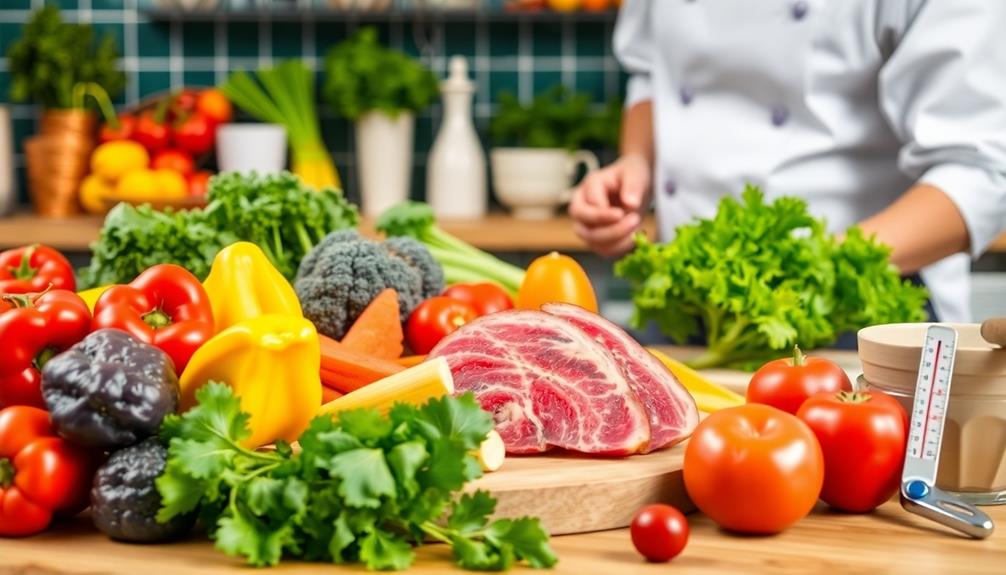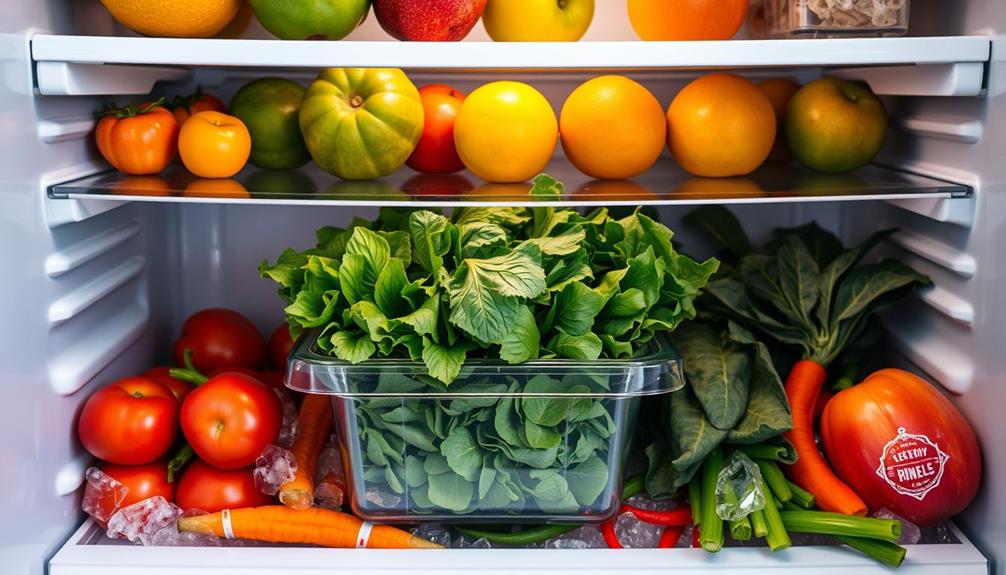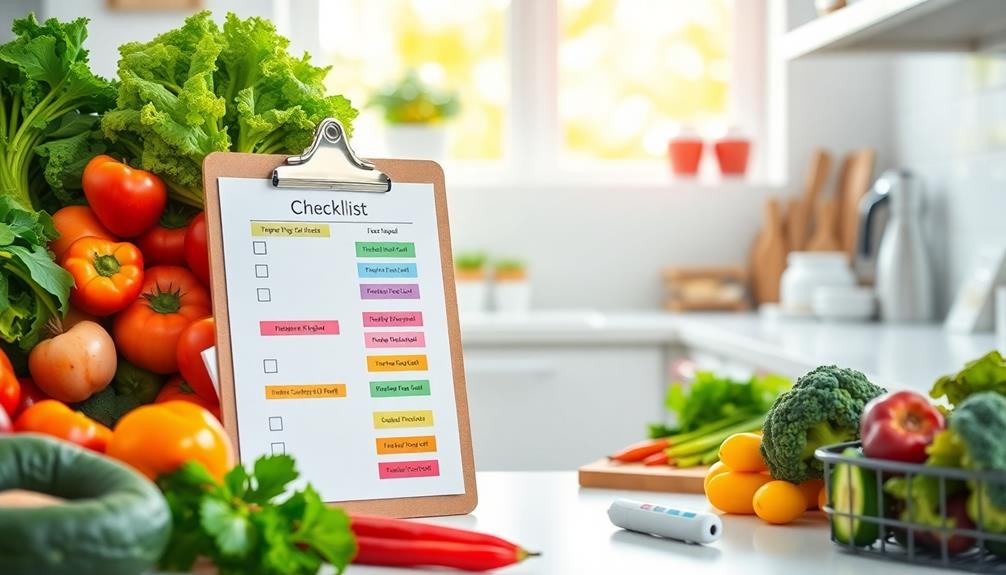When it comes to raw food preparation, several myths can compromise your safety. For instance, wearing gloves doesn't automatically prevent contamination, especially if you don't change them regularly or wash your hands frequently. You might also believe that fast food causes most foodborne illnesses, but most outbreaks actually stem from mishandling fresh produce or meals prepared at home. It's crucial to understand the real sources of foodborne threats and practice safe food handling. Staying informed about these misconceptions can greatly improve your food safety practices. There's much more to explore about keeping your meals safe and healthy.
Key Takeaways
- Raw fruits and vegetables can harbor pathogens; thorough washing and proper handling are essential to minimize risks of contamination.
- Relying solely on organic produce does not eliminate foodborne illness risks; all produce should be washed regardless of farming practices.
- Cross-contamination can occur during raw food preparation; using separate cutting boards for meat and vegetables is crucial for safety.
- Cooking is the most effective way to kill harmful bacteria; consuming raw or undercooked foods increases the risk of foodborne illness.
- Awareness of proper food storage temperatures is vital; keeping raw foods refrigerated below 40°F helps prevent bacterial growth.
Common Misconceptions About Gloves
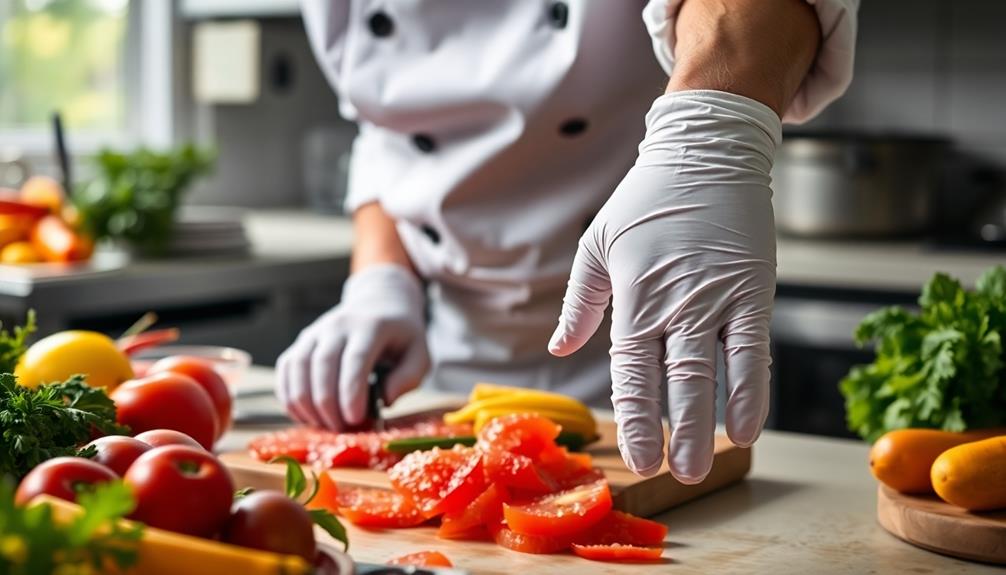
When it comes to food safety, many folks assume that wearing gloves guarantees a contamination-free environment. However, that's a common misconception. Gloves can actually lead to cross-contamination if you don't change them frequently or use them properly. Just like bare hands, gloves can transfer bacteria to food, especially after touching raw meats or contaminated surfaces.
Relying solely on gloves can create a false sense of security, causing you to skip essential practices like handwashing. It's vital to remember that safe food handling involves more than just donning a pair of gloves. The tactile sense you lose when wearing gloves can also diminish your awareness of potential contamination risks.
Frequent glove changes are necessary to minimize cross-contamination, but this practice can contribute to environmental waste since single-use gloves are usually made of plastic.
To guarantee the safest food preparation, prioritize proper hand hygiene and stay vigilant about food handling practices. Ultimately, understanding the limitations of gloves helps you create a truly safe food environment.
Understanding Foodborne Illness Timing

Understanding the timing of foodborne illness can be just as critical as proper food handling practices. You mightn't realize that symptoms can take days or even weeks to appear after consuming contaminated food. For instance, some harmful bacteria like Listeria monocytogenes can have incubation periods of up to 30 days. This delay complicates identifying the source of foodborne illness since symptoms such as vomiting and diarrhea can result from food you consumed as long as 10 days prior.
It's essential to recognize that many pathogens can remain dormant in your body for extended periods, making it tricky to link a specific meal to your illness when symptoms finally show up. This delayed reaction means you need to be aware of the incubation times of various pathogens, especially when dealing with raw meat.
Effective reporting and prevention strategies hinge on this understanding, as spotting trends in foodborne illness requires accurate timing. By being vigilant about the timing of symptoms, you can help track down the source of harmful bacteria and contribute to safer food practices in your home and community.
Myths Surrounding Fast Food Safety
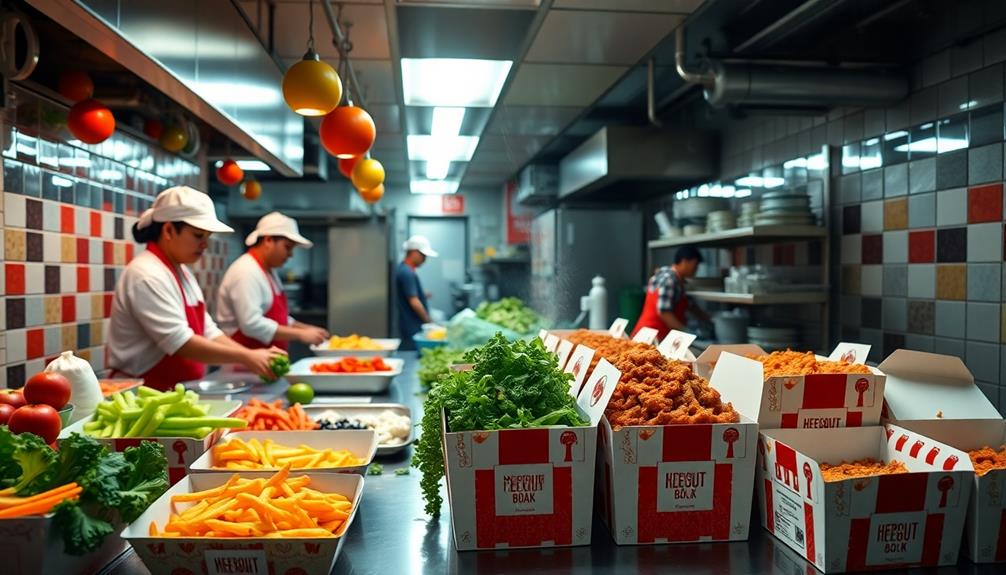
You might think fast food is the main culprit behind foodborne illnesses, but that's not the case.
In fact, outbreaks linked to fast food are less common than those from fresh produce or home-cooked meals.
Understanding the safety measures and processing steps these chains use can help clear up misconceptions about fast food safety.
Fast Food Outbreak Statistics
Fast food often gets a bad rap when it comes to safety, but the reality is quite different. Contrary to popular food safety myths, fast food chains aren't the leading sources of foodborne illness outbreaks. In fact, fewer outbreaks are linked to fast food than to other food sources like fresh produce and seafood. This might surprise you, considering the notorious cases that make headlines.
Preppy dog names can be as stylish and sophisticated as some of the fast food chains' meticulous safety protocols.
One reason for this lower risk is the extensive processing steps and use of shelf-stable ingredients at fast food restaurants. These practices greatly reduce the likelihood of pathogen survival, making your meal safer than you might think. While it's true that foodborne illness can occur in fast food establishments, statistically, these cases are less common compared to outbreaks tied to raw food poisoning from other categories.
Additionally, fast food restaurants often follow strict food safety protocols and undergo regular inspections to minimize contamination risks. By understanding the actual sources of foodborne illness, you can make more informed choices and reduce the stigma surrounding fast food safety.
Processing and Safety Measures
When it comes to food safety, many people mistakenly believe that fast food chains pose a greater risk than they actually do. In reality, these establishments often implement rigorous processing steps and safety protocols that help reduce the risk of foodborne illness. They frequently use pre-packaged and pre-cooked ingredients, which lower the chances of harmful germs thriving.
| Safety Measure | Description | Benefit |
|---|---|---|
| Strict Food Safety Protocols | Regular inspections and employee training | Minimize contamination risk |
| Pre-packaged Ingredients | Use of shelf-stable, cooked items | Less opportunity for bacteria |
| High Turnover Rates | Rapid service leads to fresher ingredients | Maintains safety standards |
Ensuring that food reaches a safe internal temperature is a priority for fast food chains. This practice, combined with swift preparation and service, enhances food safety. By understanding the actual sources of foodborne illness, you can make informed choices. Instead of relying on myths, recognize that fast food isn't the primary culprit behind food safety concerns.
Public Perception Misconceptions
Despite the rigorous safety measures in place, public perception often paints fast food as a major source of foodborne illness. Many people assume that eating fast food is risky, but statistics tell a different story.
In reality, fewer outbreaks are linked to fast food than to home-cooked meals and unprocessed foods. Fast food chains utilize processes and shelf-stable ingredients that help reduce contamination risks, making them statistically safer options.
While high-profile outbreaks can grab headlines, they're relatively rare compared to the countless meals served daily. Your risk of food poisoning from fast food is lower than you might think, especially when you consider that many illnesses arise from improper handling at home.
Understanding these facts can help clear the misconceptions surrounding fast food safety. You can feel confident that choosing fast food isn't an inherently unhealthy choice.
The Role of Trust in Food Safety

Trust plays a pivotal role in food safety, shaping how you perceive and engage with raw food preparation. When you trust the sources of information regarding safe food practices, you're more likely to adopt those methods, which can greatly reduce the risk of foodborne illnesses. Reliable information from credible sources enhances your confidence, making you feel secure in your choices.
Education is key; when you learn about foodborne risks and safe handling practices, you foster a culture of trust in food safety. This awareness encourages you to follow guidelines for washing and preparing raw foods, which is essential for minimizing contamination. The more you understand these practices, the more you'll trust the food systems around you.
Increasing your knowledge about safe food practices can influence your consumer choices and impact public health outcomes. By prioritizing trust in the sources you rely on, you not only protect yourself but also contribute to healthier communities.
Environmental Concerns of Food Practices
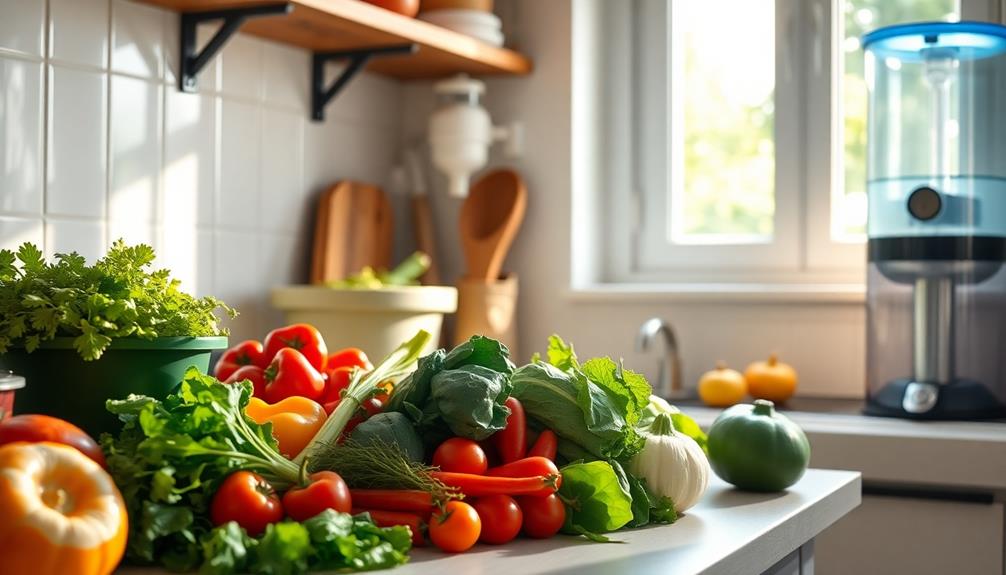
When you prepare food, think about the environmental impact of your practices.
Using disposable gloves can lead to significant plastic waste, but there are sustainable alternatives that can help reduce this issue.
Plastic Waste Reduction Strategies
Plastic waste is a growing concern in food practices, particularly with the widespread use of disposable gloves. Millions of these gloves are discarded daily, contributing considerably to environmental pollution. Instead of relying on single-use gloves, you can adopt alternatives that maintain food safety while reducing plastic waste.
Here are some effective strategies:
| Strategy | Benefits | Tips |
|---|---|---|
| Regular Handwashing | Guarantees hygiene without waste | Use soap and warm water for 20 seconds |
| Utensils Usage | Reduces reliance on single-use items | Opt for metal or bamboo utensils |
| Reusable Containers | Minimizes plastic consumption | Invest in glass or stainless steel |
| Raising Awareness | Encourages sustainable practices | Share knowledge within your community |
Sustainable Food Handling Practices
Sustainable food handling practices play an essential role in addressing environmental concerns associated with food preparation. When preparing raw meat and poultry, it's vital to prioritize safety while also minimizing waste. Instead of relying on disposable gloves, consider using utensils and practicing thorough handwashing. This not only keeps your food safe to eat but also reduces plastic waste generated from single-use items.
Utilizing reusable cleaning cloths and sanitizing methods can greatly lower your environmental footprint compared to disposable paper towels. Additionally, make certain that your cutting boards are properly cleaned and sanitized after handling raw ingredients to prevent cross-contamination.
Educating yourself about the environmental effects of food packaging can further enhance your sustainable practices. Choose local and seasonal ingredients whenever possible; they not only taste better but also reduce the carbon footprint associated with transportation.
Importance of Proper Food Handling
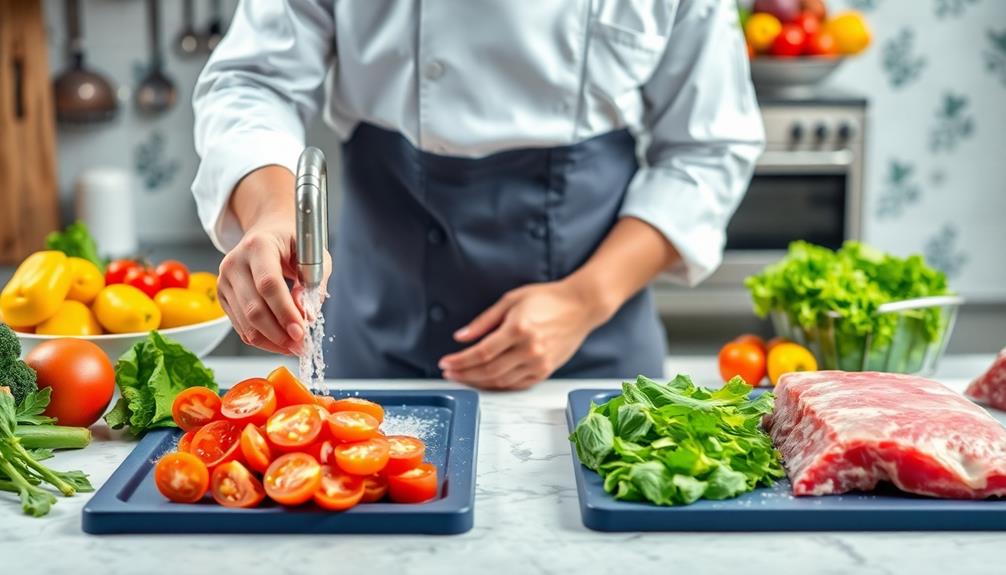
Ensuring proper food handling is essential for safeguarding your health, especially when preparing raw foods. To make sure your food is safe, you need to be mindful of cross-contamination. Bacteria can easily spread from raw meat and poultry to ready-to-eat foods, so keeping these items separate is critical.
Rinsing raw meat and poultry isn't recommended, as it doesn't remove bacteria and may contaminate other surfaces. Instead, always use separate cutting boards for raw meats and fruits and vegetables.
When it comes to fresh produce, wash your fruits and vegetables thoroughly under running water, regardless of their skins. This simple step helps reduce the risk of foodborne illness from harmful pathogens.
Additionally, maintaining a refrigerator temperature at or below 40°F is essential for inhibiting bacterial growth on raw foods and leftovers.
Frequently Asked Questions
What Precautions Should Be Taken Before Eating Raw Food?
Before eating raw food, rinse all fruits and vegetables under running water, wash your hands thoroughly, and use separate cutting boards for raw meat and produce. Scrub rinds of melons to prevent contamination while cutting.
What Might Be the Danger in Eating Raw Foods?
Eating raw foods can expose you to harmful bacteria like E. coli and Salmonella, increasing your risk of foodborne illnesses. Proper washing and handling are essential, especially for vulnerable individuals like young children and pregnant women.
What Is Usually the Riskiest Step in Food Preparation?
Preparing food without washing produce is like skipping a safety check before a road trip; it's risky. You increase the chances of harmful bacteria entering your meals, potentially leading to foodborne illnesses. Always wash your fruits and veggies!
What Are the Risk Factors in Raw Food Items?
When handling raw food items, you face risks like harmful bacteria, cross-contamination, and improper washing. Always wash produce thoroughly, avoid contact with raw meats, and store items correctly to minimize potential dangers.
Conclusion
In the world of food safety, it's easy to fall for myths that can lead you astray, much like a character in a fable who learns the hard way. By debunking these misconceptions, you're not just protecting yourself; you're becoming a champion of safe food practices. Remember, knowledge is your best ally in the kitchen. So, next time you prep a meal, don't let myths cloud your judgment—stay informed and keep your food safe!

